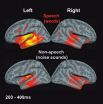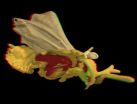(Press-News.org) Babies, even those too young to talk, can understand many of the words that adults are saying – and their brains process them in a grown-up way.
Combining the cutting-edge technologies of MRI and MEG, scientists at the University of California, San Diego show that babies just over a year old process words they hear with the same brain structures as adults, and in the same amount of time. Moreover, the researchers found that babies were not merely processing the words as sounds, but were capable of grasping their meaning.
This study was jointly led by Eric Halgren, PhD, professor of radiology in the School of Medicine, Jeff Elman, PhD, professor of cognitive science in the Division of Social Sciences, and first author, Katherine E. Travis, of the Department of Neurosciences and the Multimodal Imaging Laboratory, all at UC San Diego. The work is published this week in the Oxford University Press journal Cerebral Cortex.
"Babies are using the same brain mechanisms as adults to access the meaning of words from what is thought to be a mental 'database' of meanings, a database which is continually being updated right into adulthood," said Travis.
Previously, many people thought infants might use an entirely different mechanism for learning words, and that learning began primitively and evolved into the process used by adults. Determining the areas of the brain responsible for learning language, however, has been hampered by a lack of evidence showing where language is processed in the developing brain.
While lesions in two areas called Broca's and Wernicke's (frontotemporal) areas have long been known to be associated with loss of language skills in adults, such lesions in early childhood have little impact on language development. To explain this discordance, some have proposed that the right hemisphere and inferior frontal regions are initially critical for language, and that classical language areas of adulthood become dominant only with increasing linguistic experience. Alternatively, other theories have suggested that the plasticity of an infant's brain allows other regions to take over language-learning tasks if left frontotemporal regions are damaged at an early age.
In addition to studying effects of brain deficits, language systems can be determined by identifying activation of different cortical areas in response to stimuli. In order to determine if infants use the same functional networks as adults to process word meaning, the researchers used MEG – an imaging process that measures tiny magnetic fields emitted by neurons in the brain – and MRI to noninvasively estimate brain activity in 12 to 18-month old infants.
In the first experiment, the infants listened to words accompanied by sounds with similar acoustic properties, but no meaning, in order to determine if they were capable of distinguishing between the two. In the second phase, the researchers tested whether the babies were capable of understanding the meaning of these words. For this experiment, babies saw pictures of familiar objects and then heard words that were either matched or mismatched to the name of the object: a picture of a ball followed by the spoken word ball, versus a picture of a ball followed by the spoken word dog.
Brain activity indicated that the infants were capable of detecting the mismatch between a word and a picture, as shown by the amplitude of brain activity. The "mismatched," or incongruous, words evoked a characteristic brain response located in the same left frontotemporal areas known to process word meaning in the adult brain. The tests were repeated in adults to confirm that the same incongruous picture/word combinations presented to babies would evoke larger responses in left frontotemporal areas.
"Our study shows that the neural machinery used by adults to understand words is already functional when words are first being learned," said Halgren, "This basic process seems to embody the process whereby words are understood, as well as the context for learning new words." The researchers say their results have implications for future studies, for example development of diagnostic tests based on brain imaging which could indicate whether a baby has healthy word understanding even before speaking, enabling early screening for language disabilities or autism.
INFORMATION:
Additional contributors include Matthew K. Leonard, Timothy T. Brown, Donald J. Hagler, Jr., Megan Curran, and Anders M. Dale, all of UC San Diego School of Medicine.
The research was funded in part by the National Institutes of Health.
Babies process language in a grown-up way
2011-01-08
ELSE PRESS RELEASES FROM THIS DATE:
Quality of life measures in breast cancer clinical trials
2011-01-08
Quality of life measures tend to be most useful for clinical decision-making in trials in which quality of life is the primary outcome, according to a recent study published online January 7 in The Journal of the National Cancer Institute.
There has been increasing interest in the value of patient-reported symptom assessment in trials and their potential usage as primary or secondary endpoints in new trials. Both the World Health Organization and the U.S. Food and Drug Administration have endorsed quality of life, but they are not always incorporated into trials because ...
College students lack scientific literacy, study finds
2011-01-08
EAST LANSING, Mich. — Most college students in the United States do not grasp the scientific basis of the carbon cycle – an essential skill in understanding the causes and consequences of climate change, according to research published in the January issue of BioScience.
The study, whose authors include several current and former researchers from Michigan State University, calls for a new way of teaching – and, ultimately, comprehending – fundamental scientific principles such as the conservation of matter.
"Improving students' understanding of these biological principles ...
Clinical waste management needs specialized regulation
2011-01-08
A study carried out by the University of Granada (UGR) warns of the need to unify existing plans for clinical waste management in the different autonomous communities to improve recycling and waste disposal. There is currently no specific state-wide regulation, just a framework law that the Spanish Ministry of the Environment and Rural and Marine Affairs (MARM) is planning to reform.
"We carried out a comparison of the clinical waste management regulations and plans in place in the autonomous communities in 2008 to see if there were any differences. We observed distinctions ...
VIB-K.U. Leuven scientists clear the way to alternative anti-angiogenic cancer therapy
2011-01-08
Leuven – Scientists attached to VIB and K.U.Leuven have succeeded in decoding a potential new anti-cancer mechanism. The researchers discovered that normalizing abnormal tumor blood vessels through HRG (histidine-rich glycoprotein) prevents metastasis of tumor cells and enhances chemotherapy efficiency. In tumors, vessels formation is disturbed, leading to inefficient delivery of chemotherapeutic drugs and allowing cancer cells to escape to other parts of the body (metastasis). The normalization of tumor blood vessel formation through HRG works by repressing the production ...
Lessons learned from oil rig disaster
2011-01-08
When interviewed by the BBC, the now retired BP boss Tony Hayward admitted to his company's insufficient response to the Deepwater Horizon rig accident in the Gulf of Mexico. Could the company have been better prepared for what turned out to be one of the biggest oil disasters in history?
"We were making it up day to day," Hayward said of BP's rescue plan. Together with chairman of the board, Carl-Henrik Svenberg, he was held responsible for 11 dead and 17 injured workers. According to the New York Times, five million barrels of oil leaked into the ocean outside the coast ...
For ever and ever: When the wedding flight never ends
2011-01-08
Its stay on this planet was actually meant to be a very short one. Male twisted-wing parasites (Strepsiptera) usually have a life span of only few hours. However, accidentally a specimen of Mengea tertiara, about the size of an aphid, became preserved for 'eternity': during its wedding flight about 42 million years ago it was caught in a drop of tree resin and subsequently almost perfectly conserved in a piece of amber.
PD Dr. Hans Pohl of Friedrich Schiller University Jena (Germany) calls this "a very exceptional stroke of luck." Together with colleagues from Jena, Hamburg ...
A pesky bacterial slime reveals its survival secrets
2011-01-08
Cambridge, Mass., January 7, 2011 – By rethinking what happens on the surface of things, engineers at Harvard University have discovered that Bacillus subtilis biofilm colonies exhibit an unmatched ability to repel a wide range of liquids—and even vapors.
Centimeters across yet only hundreds of microns thick, such slimy bacterial coatings cling to the surfaces of everything from pipes to teeth and are notoriously resistant to antimicrobial agents. The researchers now suspect they know the secret to a biofilm's resiliency.
Published in the January 5th early edition of ...
Researchers pinpoint origin of deadly brain tumor
2011-01-08
Scientists have identified the type of cell that is at the origin of brain tumors known as oligodendrogliomas, which are a type of glioma – a category that defines the most common type of malignant brain tumor.
In a paper published in the December 2010 issue of the journal Cancer Cell, investigators found that the tumor originates in and spreads through cells known as glial progenitor cells – cells that are often referred to as "daughter" cells of stem cells. The work comes at a time when many researchers are actively investigating the role that stem cells which have ...
Rice U. research shows Starbucks' logo redesign could prove beneficial to company
2011-01-08
Despite U.S. consumers' threats of protests in response to the redesigned Starbucks logo unveiled yesterday, the new look may be a smart move in the long run as the coffee company expands into Asian markets, according to a Rice University researcher who has studied consumer reaction to logos.
"The logo of a brand is much more than a pictorial representation of the brand," said Rice Professor of Marketing Vikas Mittal, who has co-authored two studies on customers, logos and brand commitment. "For consumers who are highly committed to the brand, the logo represents a visual ...
Most consumers want predictive tests to learn if a disease is in their future
2011-01-08
BOSTON, Mass.––Consumers may place a high value on information to predict their future health, and may be willing to pay out of pocket to get it. In a national survey conducted by researchers at Tufts Medical Center, roughly 76% of people indicated that they would take a hypothetical predictive test to find out if they will later develop Alzheimer's disease, breast or prostate cancer, or arthritis. On average, respondents were willing to pay $300 to $600, depending on the specific disease and the accuracy of the test.
Published online in the journal Health Economics, ...




